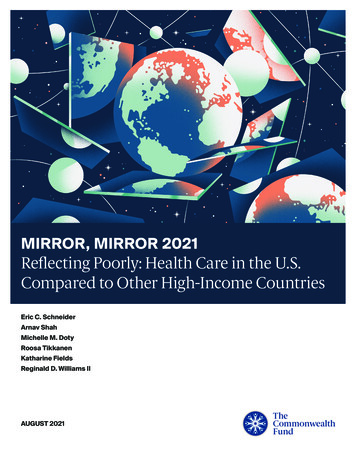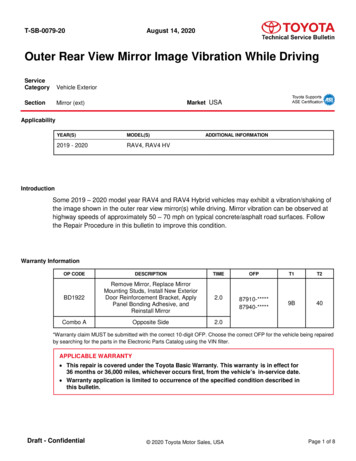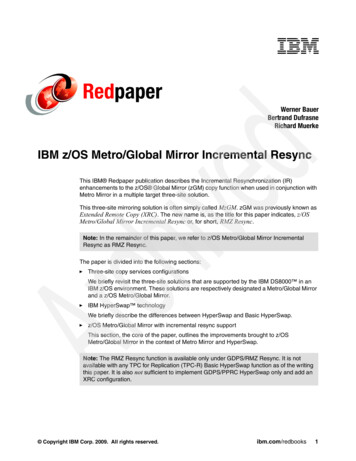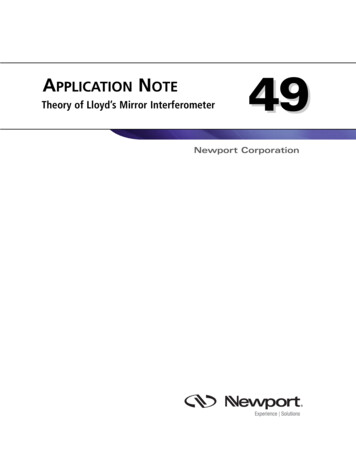
Transcription
MIRROR, MIRROR 2021Reflecting Poorly: Health Care in the U.S.Compared to Other High-Income CountriesEric C. SchneiderArnav ShahMichelle M. DotyRoosa TikkanenKatharine FieldsReginald D. Williams IIAUGUST 2021
AUGUST 2021MIRROR, MIRROR 2021Reflecting Poorly: Health Care in the U.S.Compared to Other High-Income CountriesAUTHORSABSTRACTEric C. SchneiderIssue: No two countries are alike when it comes to organizing andArnav ShahMichelle M. DotyRoosa TikkanenKatharine FieldsReginald D. Williams IIdelivering health care for their people, creating an opportunity to learnabout alternative approaches.Goal: To compare the performance of health care systems of 11 highincome countries.Methods: Analysis of 71 performance measures across five domains —TOPLINESThe United States trails farbehind other high-incomecountries on measures of healthcare affordability, administrativeefficiency, equity, and outcomes.Lessons from the topperformers can inform theUnited States and othercountries seeking to improvetheir health care systems.access to care, care process, administrative efficiency, equity, and healthcare outcomes — drawn from Commonwealth Fund internationalsurveys conducted in each country and administrative data from theOrganisation for Economic Co-operation and Development and theWorld Health Organization.Key Findings: The top-performing countries overall are Norway, theNetherlands, and Australia. The United States ranks last overall, despitespending far more of its gross domestic product on health care. The U.S.ranks last on access to care, administrative efficiency, equity, and healthcare outcomes, but second on measures of care process.Conclusion: Four features distinguish top-performing countries fromthe United States: 1) they provide for universal coverage and remove costbarriers; 2) they invest in primary care systems to ensure that high-valueservices are equitably available in all communities to all people; 3) theyreduce administrative burdens that divert time, efforts, and spendingfrom health improvement efforts; and 4) they invest in social services,especially for children and working-age adults.
Mirror, Mirror 2021 — Reflecting Poorly: Health Care in the U.S. Compared to Other High-Income CountriesINTRODUCTION3For our assessment of health care system performanceNo two nations are alike when it comes to healthcare. Over time, each country has settled on aunique mix of policies, service delivery systems,and financing models that work within itsresource constraints. Even among high-incomenations that have the option to spend more onhealth care, approaches often vary substantially.These choices affect health system performancein terms of access to care, patients’ experienceswith health care, and people’s health outcomes.In this report, we compare the health systems of11 high-income countries as a means to generateinsights about the policies and practices that areassociated with superior performance.With the COVID-19 pandemic imposing an unprecedentedstress test on the health care and public health systems of allnations, such a comparison is especially germane. Success incontrolling and preventing infection and disease has variedgreatly. The same is true of countries’ ability to address thechallenges that the pandemic has presented to the workforce,operations, and financial stability of the organizationsdelivering care. And while the comparisons we draw arebased on data collected prior to the pandemic or duringthe earliest months of the crisis, the prepandemic strengthsand weaknesses of each country’s preexisting arrangementsfor health care and public health have undoubtedly beenshaping its experience throughout the crisis.in Australia, Canada, France, Germany, the Netherlands,New Zealand, Norway, Sweden, Switzerland, the UnitedKingdom, and the United States, we used indicatorsavailable across five domains: Access to care Care process Administrative efficiency Equity Health care outcomes.For more information on these performance domainsand their component measures, see How We MeasuredPerformance. Most of the data were drawn from surveysexamining how members of the public and primary carephysicians experience health care in their respectivecountries. These Commonwealth Fund surveys wereconducted by SSRS in collaboration with partnerorganizations in the 10 other countries. Additionaldata were drawn from the Organisation for EconomicCo-operation and Development (OECD) and the WorldHealth Organization (WHO).HOW THE 11 COUNTRIES RANK ONPERFORMANCEThe top-performing countries overall are Norway, theNetherlands, and Australia (Exhibit 1).Exhibit 1. Health Care System Performance RankingsAUSCANFRAGERNETHNZOVERALL RANKING310852652Care Process6410931Administrative Efficiency27698Equity11072Health Care Outcomes11067Access to 9111NOR SWE17411Data: Commonwealth Fund analysis.commonwealthfund.orgReport August 2021
Mirror, Mirror 2021 — Reflecting Poorly: Health Care in the U.S. Compared to Other High-Income CountriesChange in Rankings Since the 2017Edition of Mirror, MirrorReaders familiar with the previous edition of thisreport (2017) will notice that some of the countryranks have changed. These changes should beinterpreted with caution. While most of the 71measures included in the new edition are identicalto those used in 2017, 10 measures were modifiedbecause survey items, response categories, oravailable data changed. We replaced 17 of the2017 measures with 16 new measures to reflectnewly available data as well as to better representpreviously defined performance domains andsubdomains. An expert advisory panel reviewedthe proposed changes. See Appendix 2 for moredetail on the changes by domain.Readers should interpret changes in ranks in thecontext of the statistical variation in countries’performance scores (as visualized in Exhibit 2,for example). We calculated performancedifferences as the standard deviation from “averageperformance” — a measure of the degree ofdifference between countries given the range ofvariation in this set of countries.Depending on the domain, some countries havequantitatively similar performance scores, meaningthat very small differences can produce changesin rankings. The U.K.’s drop in rank from #1 to #4 isassociated with that country’s lower performanceon several domains (such as access to care andequity) compared to 2017.For more on the differences between the 2017 and2021 editions of this report, please see How WeConducted This Study.commonwealthfund.org4The next three countries in the ranking — the U.K.,Germany, and New Zealand — perform very similarlyto one another (Exhibit 2). The U.S. ranks #11 — last.Exhibit 2 shows the extent to which the U.S. is an outlier:its performance falls well below the average of theother countries and far below the two countries rankeddirectly above it, Switzerland and Canada. In fact, theU.S. is such an outlier that we have calculated the averageperformance based on the other 10 countries, excludingthe U.S. (see How We Measured Performance). The U.S. islast on all domains of performance except care process, onwhich it ranks #2.Exhibit 3 shows that while spending as a share of grossdomestic product (GDP) has increased in all countries,spending growth in the U.S. — by far the worst performeroverall — has greatly exceeded growth in the other 10nations. In 1980, high-income countries spent between5 percent and 8 percent of GDP on health care. But asU.S. spending accelerated over the decades, the U.S. wasspending a substantially larger share of its GDP on healthcare by 2019 than every other high-income country.Exhibit 4 starkly shows just how much the U.S. is an outlierfrom the other nations when its performance as a healthcare system is compared to its spending as a share of GDP.Access to CareUniversal, Affordable Coverage Is ParamountAccess to care includes measures of health care’s affordabilityand timeliness. The Netherlands performs best on thisperformance domain among the 11 countries, ranking at ornear the top in both subdomains. Norway and Germany alsoperformed well on access to care (Exhibit 1), but all three areoutranked on affordability by the U.K. (Exhibit 5).Overall, the U.S. is #11 — last — on access to care (Exhibit 1).The U.S. has the poorest performance on the affordabilitysubdomain, scoring much lower than even the next-lowestcountry, Switzerland (Exhibit 5). Compared to residentsof the U.S., residents of the Netherlands, the U.K., Norway,and Germany are much less likely to report that theirinsurance denied payment of a claim or paid less thanexpected. Residents of these countries are also less likely toreport difficulty in paying medical bills (Appendix 4).People in the countries performing the best on the timelinesssubdomain are more likely to be able to get same-day careand after-hours care. The U.S. ranked #9 on timeliness.Report August 2021
Mirror, Mirror 2021 — Reflecting Poorly: Health Care in the U.S. Compared to Other High-Income Countries5EXHIBIT 2ComparativeHealth Care System Performance ScoresExhibit 2. Comparative Health Care System Performance ScoresHigherperformingNORNETHTop-3 averageAUSUKGERNZ10-country averageSWEFRASWIZCANUSLowerperformingNote: To normalize performance scores across countries, each score is the calculated standard deviation from a 10-country average thatexcludes the US. See How We Conducted This Study for more detail.Data: Commonwealth Fund analysis.EXHIBIT3Note:To normalizeperformance scores across countries, each score is the calculated standard deviation from a 10-country average that excludes the US. See How We Conducted This Study formore detail.Data: Commonwealth Fund analysis.Healthasasa PercentageGDP,1980–2019Exhibit3. CareHealthSpendingCare Spendinga Percentage ofofGDP,1980–2019Source: Eric C. Schneider et al., Mirror, Mirror 2021 — Reflecting Poorly: Health Care in the U.S. Compared to Other High-Income CountriesPercent (%) of GDP(Commonwealth Fund, Aug. 2021).18162019* data:14US (16.8%)12SWIZ (11.3%)10FRA (11.1%)GER (11.7%)SWE (10.9%)8CAN (10.8%)NOR (10.5%)6UK (10.2%)NETH (10.2%)4AUS (9.4%)20NZ (9.1%)19801985199019952000200520102015Notes: Current expenditures on health. Based on System of Health Accounts methodology, with some differences between countrymethodologies. GDP refers to gross domestic product.* 2019 data are provisional or estimated for Australia, Canada, and New Zealand.Notes: Current expenditures on health. Based on System of Health Accounts methodology, with some differences between country methodologies. GDP refers to gross domestic product.Data:OECD Health Data, July 2021.* 2019 data are provisional or estimated for Australia, Canada, and New Zealand.Data: OECD Health Data, July 2021.commonwealthfund.orgSource: Eric C. Schneider et al., Mirror, Mirror 2021 — Reflecting Poorly: Health Care in the U.S. Compared to Other High-Income Countries(Commonwealth Fund, Aug. 2021).Report August 2021
Mirror, Mirror 2021 — Reflecting Poorly: Health Care in the U.S. Compared to Other High-Income Countries6EXHIBIT 4Health Care System Performance Compared to SpendingExhibit 4. Health Care System Performance Compared to 00NZNETH-0.20NORGERUKSWEFRA-0.4010-country ce-1.00-1.20-1.40US0%2%4%Lower health carespending6%8%10%12%14%16%18%Higher health carespendingHealth care spending as a % of GDPNotes: Health care spending as a percent of GDP. Performance scores are based on standard deviation calculated from the 10-country averagethat excludes the US. See How We Conducted This Study for more detail.Note: Healthcare spendingas a frompercentof GDP.forPerformancebased on instandarddeviation calculated from the 10-country average that excludes the US. See How We Conducted ThisData:Spendingdata areOECDthe yearscores2019are(updatedJuly 2021).Study for more detail.Data: Spending data are from OECD for the year 2019 (updated in July 2021).EXHIBIT 5Health Care System Performance Scores: AffordabilitySource: Eric C. Schneider et al., Mirror, Mirror 2021 — Reflecting Poorly: Health Care in the U.S. Compared to Other High-Income Countries(CommonwealthAug. 2021). Care System Performance Scores: KNETHTop-3 averageNORGERSWEFRA10-country averageNZCANAUSSWIZUSLowerperformingNote: To normalize performance scores across countries, each score is the calculated standard deviation from a 10-country average thatexcludes the US. See How We Conducted This Study for more detail.Data: Commonwealth Fund analysis.commonwealthfund.orgReport August 2021Note: To normalize performance scores across countries, each score is the calculated standard deviation from a 10-country average that excludes the US. See How We Conducted This Stud
Mirror, Mirror 2021 — Reflecting Poorly: Health Care in the U.S. Compared to Other High-Income Countries7Care Processface during care. The top performers on the administrativeefficiency domain are Norway, Australia, New Zealand,and the U.K. (Exhibit 1). The U.S. ranks last.Care process includes measures of preventive care, safe care,coordinated care, and engagement and patient preferences.The U.S. ranks #2 on this performance domain (Exhibit 1).Along with the U.K. and Sweden, the U.S. achieves higherperformance on the preventive care subdomain, whichincludes rates of mammography screening and influenzavaccination as well as the percentage of adults whotalked with their provider about nutrition, smoking, andalcohol use. New Zealand and the U.S. perform best onthe safe care subdomain, with higher reported use ofcomputerized alerts and routine review of medications.Still, in all countries, more than 10 percent of adults reportexperiencing medical or medication mistakes in their care.U.S. doctors are the most likely to have trouble getting theirpatients medication or treatment because of restrictionson insurance coverage. Compared to most of the othercountries, larger percentages of adults in the U.S. say theyspend a lot of time on paperwork related to medical bills.For nonemergency care, U.S. and Canadian adults are alsomore likely to visit the emergency department — a lessefficient option than seeing a regular doctor.The U.S. Compares Favorably on Preventive Care,Safe Care, and Engagement and Patient PreferencesNew Zealand, Switzerland, and the Netherlands performbest among countries on the coordinated care subdomain.Switzerland, New Zealand, Australia, Norway, and Franceperform well on measures related to communicationbetween primary care doctors and specialists. No countrystood out at achieving good communication between theprimary care and hospital, emergency department, andhome-based care provider or coordination with local socialservices providers.The U.S. and Germany achieve the highest performanceon the engagement and patient preferences subdomain,although U.S. adults have the lowest rates of continuitywith the same doctor. Among people with chronic illness,U.S. adults are among the most likely to discuss goals,priorities, and treatment options with their provider,though less likely to receive as much support from healthprofessionals as they felt was needed.Use of web-based portals for communicating medicalconcerns and refilling medications is highest among adultsin Norway and the U.S. In the year prior to the COVID-19pandemic, primary care clinicians in Sweden and Australiawere the most likely to report using video consultations.Administrative EfficiencyMany Countries Simplify Insurance Coverage,Billing, and PaymentAdministrative efficiency refers to how well healthsystems reduce documentation (paperwork) and otherbureaucratic tasks that patients and clinicians frequentlycommonwealthfund.orgEquityIncome-Related Disparities Are Largest in the U.S.,Canada, New Zealand, and NorwayOur analysis of equity focuses on income-related disparities,based on standardized data across the 11 countries, in theaccess to care, care process, and administrative efficiencyperformance domains. Similar standardized data are notavailable for measuring equity in performance with respectto different racial and ethnic groups (see How We MeasuredPerformance for more detail).Australia, Germany, and Switzerland rank highest on theequity domain, meaning these countries had the smallestincome-related disparities in performance based on theincluded measures (Exhibit 6).Within these countries, experiences reported by peoplein lower- and higher-income groups on 11 indicators inthe affordability, timeliness, preventive care, safe care, andengagement and patient preferences subdomains are lessdivergent than they are within other countries (Appendix 7).In contrast, the U.S. consistently demonstrated the largestdisparities between income groups, except for thosemeasures related to preventive services and safety of care.U.S. disparities are especially large when looking at financialbarriers to accessing medical and dental care, medical billburdens, difficulty obtaining after-hours care, and use ofweb portals to facilitate patient engagement. Compared tothe other countries, the United States and Canada had largerincome-related inequities in patient-reported experiences.Exhibit 7 illustrates the importance of comparing countryperformance on equity: relatively good performance ona health care measure overall may mask pronouncedgaps in the experiences of lower-income versus higherincome groups. It also illustrates the challenge that arisesReport August 2021
Mirror, Mirror 2021 — Reflecting Poorly: Health Care in the U.S. Compared to Other High-Income Countries8EXHIBIT 6HealthCare System Performance Scores: EquityExhibit 6. Health Care System Performance Scores: EquityHigherperformingAUSGERTop-3 averageSWIZUKNETH10-country averageSWEFRANORNZCANUSLowerperformingNote: To normalize performance scores across countries, each score is the calculated standard deviation from a 10-country average thatexcludes the US. See How We Conducted This Study for more detail.Data: Commonwealth Fund analysis.EXHIBIT 7Cost-Related Access Problems Affect Low Income Populations,Exhibit 7. Cost-Related Access Problems Affect Low-Income Populations,Especiallyin U.S.the U.S.Especiallyin theNote: To normalize performance scores across countries, each score is the calculated standard deviation from a 10-country average that excludes the US. See How We Conducted This Studymore detail.Data: Commonwealth Fund analysis.Percent who reported any cost-related access problem to medical care in past year, 2020Source: Eric C. Schneider et al., Mirror, Mirror 2021 — Reflecting Poorly: Health Care in the U.S. Compared to Other High-Income Countries(CommonwealthFund, Aug. 2021).Lower incomeHigher 17CAN272715926AUSSWIZNZUSDefinition of cost-related access problem: Skipped needed doctor visits, tests, treatments, follow-up, or prescription medicines because of costin the past year.Definitionof cost-relatedaccess problem:Skippedneeded doctorvisits, tests,treatments,or prescription medicines because of cost in the past olicySurveyfollow-up,of Adults.Data: 2020 Commonwealth Fund International Health Policy Survey.Source: Eric C. Schneider et al., Mirror, Mirror 2021 — Reflecting Poorly: Health Care in the U.S. Compared to Other High-Income Countriescommonwealthfund.org(Commonwealth Fund, Aug. 2021).Report August 2021
Mirror, Mirror 2021 — Reflecting Poorly: Health Care in the U.S. Compared to Other High-Income Countries9in assessing equity without also considering performanceoverall: income-related differences on a measure may besmall, but a nation’s performance may be comparativelypoor for both higher- and lower-income groups.The U.S. ranks last overall on the health care outcomesIn Exhibit 7, income-related performance disparitiesin Switzerland and Australia are as small as those inGermany and the U.K. But the cost-related access problemsfor higher-income residents of Switzerland and Australiaresemble the levels seen among lower-income residents ofthe Netherlands and Canada. Adults with higher incomesin the U.S., Switzerland, and Australia are as likely as,or more likely than, adults with lower incomes in fivecountries to report cost-related access problems.mortality rate (5.7 deaths per 1,000 live births) and lowestdomain (Exhibit 1). On nine of the 10 componentmeasures, U.S. performance is lowest among the countries(Appendix 8), including having the highest infantlife expectancy at age 60 (23.1 years). The U.S. ranks laston the mortality measures included in this report, withthe exception of 30-day in-hospital mortality followingstroke. The U.S. rate of preventable mortality (177 deathsper 100,000 population) is more than double the bestperforming country, Switzerland (83 deaths per 100,000).The U.S. has exceptionally poor performance on two otherhealth care outcome measures. Maternal mortality is one:Health Care Outcomesthe U.S. rate of 17.4 deaths per 100,000 live births is twiceMany Countries Achieve Better Outcomes DespiteLower SpendingHealth care outcomes reported here refer to those healthoutcomes that are most likely to be responsive to healthcare. On this domain, Australia, Norway, and Switzerlandrank at the top of our 11-nation group (Exhibit 1). Norwayhas the lowest infant mortality rate (two deaths per 1,000live births), while Australia has the highest life expectancyafterage8 60 (25.6 years of additional life expectancy forEXHIBITthose who survive to age 60).that of France, the country with the next-highest rate (7.6deaths per 100,000 live births).The second is the 10-year trend in avoidable mortality. Asdepicted in Exhibit 8, all countries reduced their rate ofavoidable mortality over 10 years, but the U.S., with thehighest level in 2007, reduced it by the least amount —5 percent reduction in deaths per 100,000 population by2017 — compared to 25 percent in Switzerland (by 2017)and 24 percent in Norway (by 2016).Avoidable Deaths and Ten-Year Reductionin Avoidable MortalityAcross8.CountriesExhibitAvoidable Deaths and Ten-Year Reduction in Avoidable Mortality Across CountriesDeaths per 100,000 population2802402009 (or most recent year)-5%2019 (or most recent ��GERUK‡US†Notes: Health status: avoidable mortality. Data years are: 2009 and 2019 (Germany); * 2008 and 2018 (Australia, the Netherlands, Sweden);† 2007 and 2017 (Canada, Switzerland, US); and ‡ 2006 and 2016 (France, New Zealand, Norway, UK).Data:Commonwealthanalysisof are:datafromHealthStatistics,2021.Notes: Healthstatus: avoidableFundmortality.Data years2009and OECD2019 (Germany);* 2008and 2018 July(Australia,the Netherlands, Sweden); † 2007 and 2017 (Canada, Switzerland, US); and ‡ 2006and 2016 (France, New Zealand, Norway, UK).Data: Commonwealth Fund analysis of data from OECD Health Statistics, July 2021.commonwealthfund.orgSource: Eric C. Schneider et al., Mirror, Mirror 2021 — Reflecting Poorly: Health Care in the U.S. Compared to Other High-Income CountriesReport August 2021
Mirror, Mirror 2021 — Reflecting Poorly: Health Care in the U.S. Compared to Other High-Income CountriesDISCUSSIONSome high-income nations get more for their health dollars than the U.S. does.As nations strive for better health care and better health for their residents,several basic lessons emerge from our findings.Achieving better health outcomes will require policy changeswithin and beyond health care.The striking contrast in performance between the U.S. and other high-incomecountries on avoidable mortality measures points to several interventionor policy targets. How have top-performing countries reduced avoidablemortality? A comparison of the features of top-performing countries andpoorer-performing countries suggests that top-performing countries rely onfour features to attain better and more equitable health outcomes:1.They provide for universal coverage and remove cost barriers so people canget care when they need it and in a manner that works for them.2.They invest in primary care systems to ensure that high-value services areequitably available locally in all communities to all people, reducing therisk of discrimination and unequal treatment.3.They reduce the administrative burdens on patients and clinicians thatcost them time and effort and can discourage access to care, especially formarginalized groups.4.They invest in social services that increase equitable access to nutrition,education, child care, community safety, housing, transportation, andworker benefits that lead to a healthier population and fewer avoidabledemands on health care.10Health Care Outcomesvs. Health OutcomesHealth outcomes areinfluenced by a wide varietyof social and economicfactors, many of them outsidethe control of health caresystems. Policies and publicinvestments in education,employment, nutrition,housing, transportation, andenvironmental safety shapethe health of the population.Our report focuses on healthcare outcome metrics —those outcomes that can beimproved by the delivery ofhealth care services.Compared to other OECDcountries, the U.S. spendsrelatively less on socialprograms such as earlychildhood education, parentalleave, and income supportsfor single parents. TheU.S. also spends less onsupports for workers, such asunemployment protectionsand labor market incentives.Labor market policies inparticular have been linked toso-called deaths of despair,including suicides andoverdose deaths.U.S. health outcomes couldtherefore be improvedthrough actions targetingfactors beyond health care.Accountable Communitiesfor Health offer one promisingapproach to improving healthoutcomes as well as equity.commonwealthfund.orgReport August 2021
Mirror, Mirror 2021 — Reflecting Poorly: Health Care in the U.S. Compared to Other High-Income Countries11Prioritizing maternal health is critical for reducing maternal mortality.Top-performing countries have had success in preventing maternal deathsthrough the removal of cost sharing for maternal care. They invest in primarycare models that ensure continuity of care from conception through thepostpartum period, including midwife-led models. They offer social supportbenefits, including parental leave.Several additional causes of avoidable mortality are linked to mental health.Higher rates of suicide in the U.S. — rates that have increased every yearsince 2000 — could be addressed by expanding the capacity of primarycare to diagnose comorbid mental health conditions and provide earlyintervention and treatment as well as promote social connectedness andsuicide prevention. Compared to other countries, the U.S. has a comparativelysmaller workforce dedicated to meeting mental health needs. Countries likethe Netherlands, Sweden, and Australia more frequently include mentalhealth providers on primary care teams.Improving access to care requires expandingand strengthening insurance coverage.The U.S. remains the only high-income country lackinguniversal health insurance coverage. With nearly 30million people still uninsured and some 40 million withhealth plans that leave them potentially underinsured,out-of-pocket health care costs continue to mar U.S. healthcare performance.Top-performing countries achieve near-universal coverageand much higher levels of protection against medicalcosts in the form of annual out-of-pocket caps on coveredbenefits and full coverage for highly beneficial preventiveservices, primary care, and effective treatments forchronic conditions. Germany abolished copayments forphysician visits in 2013, while several countries have fixedannual out-of-pocket maximums for health expenditures(ranging from about USD 300 per year in Norway to USD2,645 in Switzerland).Australia addresses income-related equity through a mixof annual spending caps that are lower for low-incomeindividuals as well as incentives for people to seekprimary care. In 2019, 86 percent of Australians faced noout-of-pocket costs for primary care visits.commonwealthfund.orgReport August 2021
Mirror, Mirror 2021 — Reflecting Poorly: Health Care in the U.S. Compared to Other High-Income Countries12Improving access to care requires strengthening primary careand extending it to every local community.Access to care, however, requires more than insurancecoverage. Convenient and timely primary care is also vital.Top-ranking countries like the Netherlands and Norwayensure timely availability to care by phone on nights andweekends (with in-person follow-up at home as needed).In the Netherlands, cooperative “GP posts” are staffedby general practitioners (primary care physicians), whoare obligated to provide at least 50 hours of after-hourscare (between 5:00 pm and 8:00 am) annually in orderto maintain their professional licensure. In Norway,the Patients’ Rights Act specifies a right to receive carewithin specific timeframes and with maximum waittimes applying to covered services, including generalpractitioner visits, hospital care, mental health care, andsubstance use treatment.In top-performing countries, workforce policy is gearedto ensuring access within communities, especiallythose that have been historically marginalized. Norway, with the highestnumber of doctors per person among the 11 countries in our study, has amuch larger supply of physicians relative to its population than the U.S. has.Outside the U.S., a larger proportion of clinicians are devoted to primary careand are geographically distributed to match population needs. For example,Norwegian local municipalities, which are responsible for the supply of GPs,may apply to the national government for extra funding to ensure they have anadequate number of physicians.Reducing administrative burden can freeup resources to devote to improving health.Administrative requirements cost both
Mirror, Mirror 2021 — Reflecting Poorly: Health Care in the U.S. Compared to Other High-Income Countries 4 The next three countries in the ranking — the U.K., Germany, and New Zealand — perform very similarly to one another (Exhibit 2). The U.S. ranks #11 — last. Exhibit 2 shows the extent to which the U.S. is an outlier:










